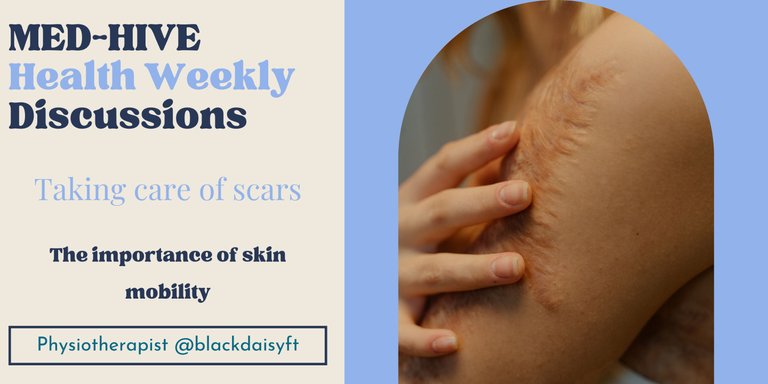

Greetings fellow colleagues 🤗
Hello everyone! I'm so excited today to write about my work, read some scientific papers and share it with you on the MED-HIVE community 🤗. The topic the community is promoting this month is skin health, and I initially thought I had nothing to add or contribute.
It was until the beginning of this week, when I was evaluating a patient, that I realized I could bring to light a vital topic related to our skin. One that maybe a lot of us have experienced, and that is...scars. As I'm feeling so excited to talk about this, today I have planned quite a few things (note to self - Shit! Long post coming again 😅) .
First, I'll start with the scientific language to the med-hivers, where I'll share the most updated evidence-based information (note to self - that I could find) on scar management as well as add what my work is on this type of situation. Then, I'll share with you a clinical case where I'll guide you through my clinical evaluation of a scar.
I'm so hyped!! Let's do this 🙌 !!

Source

Critical review and reflection 🤔
According to the literature, scars are the representation of...
visible sequelae of trauma, injury, burn, or surgery. They may induce distress in the patient because of their aesthetically unpleasant appearance, especially if they are excessively raised, depressed, wide, or erythematous.
Ibrahim Khansa, Bridget Harrison, Jeffrey E Janis, 2016
In my work, one of my expertise is on Women's Health, and it's often in the post-partum phase of a woman's life that I jump into the scene. In fact, the unpleasant appearance of a cesarean scar is the most recurrent issue my patients come to seek help with.
My clinical experience is on the same page as the evidence related to the aesthetically, as patients often complain of a depressed c-section scar making an illusion that the person has two little bellies, thus affecting their quality of life, well-being and body image.
Coincidentally, this week I went to a house call to do a post-partum evaluation of a patient that had to do a cesarean. This type of clinical evaluation, in my work, always includes evaluating possible scars either from a cesarean, episiotomy or laceration. Sometimes, it's not only the aesthetically unpleasant appearance that affects the patient. Not as few times as we would like, scars may also...
(...) cause the patient symptoms of pain, tightness, and pruritus.
Ibrahim Khansa, Bridget Harrison, Jeffrey E Janis, 2016
Other possible consequences that might occur are hypertrophic scars and keloids. Unfortunately,...
Hypertrophic scars and keloids resulting from surgery, burns, trauma and infection can be associated with substantial physical and psychological distress.
Meaume S, Le Pillouer-Prost A, Richert B, Roseeuw D, Vadoud J., 2014
As a physiotherapist, pain, function and movement are my top priorities and I often look at scars from a mobility point of view. I try to understand how scar fibbers in our skin, fascia, periosteum and muscles can affect our daily function either through pain or restrained ranges of motion.
I believe in the importance of always mobilising your scar, through touch or massage, as a preventive measure to avoid the formation of hypertrophic scars and keloids, thus preventing pain and loss of function.
If you are a health professional who deals with scars I strongly recommend the careful review and reading of this free scientific article. They have a few interesting images with diagrams for clinical reasoning. They include the most effective methods, validated for their safety and efficacy on scar healing.
According to those authors, we have a few non-invasive management options for scars and those include:
Medical ointments and creams may be useful for reducing scar pruritus and physical therapies may also be valuable as part of overall scar management.
Meaume S, Le Pillouer-Prost A, Richert B, Roseeuw D, Vadoud J., 2014
In the physical therapies section, we have interesting information as well. As the authors state,
Physical treatments for scars include massage therapy and physiotherapy (e.g., splinting and taping). These treatments should be combined with silicone and pressure therapy when possible.
Meaume S, Le Pillouer-Prost A, Richert B, Roseeuw D, Vadoud J., 2014
So far this is working great for my side, however, we must stay true to science! And as far as massage therapy goes...
there is only very weak clinical evidence currently available to support its use.
Meaume S, Le Pillouer-Prost A, Richert B, Roseeuw D, Vadoud J., 2014
However, we must be open-minded and critical in our understanding of an author's findings. I believe one of the reasons that might explain the weak clinical evidence is that the validated tests and methodology used isn't sensitive enough to detect the subtle changes in function, fluid/coordinated and healthy movement.
Do not fear, not all is lost! The paper goes on and...
Available data suggests that massage therapy may reduce pruritus and pain, and may improve the range of motion and appearance of the scar.
Meaume S, Le Pillouer-Prost A, Richert B, Roseeuw D, Vadoud J., 2014
I will always advocate for taking care of our scars with love, touch and movement. I always tell my patients that scars are to be moved, touched and massaged and I always try to explain to them why.
However, there are a few things to consider when I see a scar. We cannot forget the physiology and healing process of a wound and,
(...) the type of massage therapy should be adapted to the stage of scar maturation.
This is why I recommend every doctor to always refer their patients to a physiotherapist after surgery, even the little and minimal-evasive ones. There will always be a scar after an injury, trauma or surgery and they should be evaluated by a health professional that focuses on rehabilitation and function. We have an uninterrupted fascia that is disturbed and that contributes to function and movement on a deep level.
The physiotherapist must do clinical reasoning and recommend a personalized plan of treatment that focuses on restoring range of motion, overall function, well-being and the most pleasant appearance possible.

A clinical case 🙌
I would like to share with you a clinical case of the scar I evaluated this week, so we can all think together and see this type of evaluation from my point of view. Thankfully I remembered to ask for a photo of the patient that kindly permitted me to use for educational purposes.
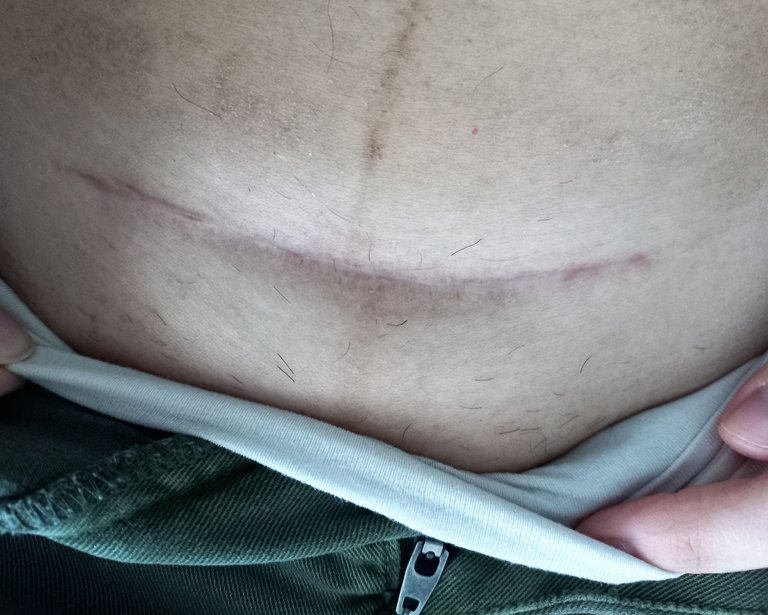
First of all, before I touch or do anything to the patient I present myself and ask her about the reason why she sought my help. I listen and I retain valuable clinical information such as pain or discomfort complaints, body image issues or others.
To mention, I followed this patient throughout pregnancy, so I knew her previously and this first part was skipped. In this case, she came to check how her scar was going in the healing process. There were no initial pain complaints or others.
Then I ask for the previous clinical history such as previous surgeries, accidents, pregnancies, previous labours or scars. I also check up on previous complaints related to old scars.
In this case, this was the 2nd cesarean for this patient and there is an old scar behind this one. You can see the old line of the previous scar on the patient's right side. I also knew that because I knew this patient from her first post-partum period so I know she mobilized and massaged her previous scar. If I didn't have that information I would ask the patient what measures she applied for taking care of it.
Afterwards, I explain to the patient what the physical exam will be like, and what I'll be doing or touching and I get her consent. I always point out that if there is anything that she doesn't want to do or feels any type of discomfort tell me to stop.
Then, I'll do a quick standing posture evaluation and I'm looking to see if she adopts a more curved, arched back posture that can point out a possible restrain on hip motion or discomfort at lengthening the abdominal zone. Or on the other hand, I have a strong, active posture with a more neutral spine.
Usually, during the post-partum period, the curved posture is the most common I find and it happens for very different reasons, so one must be careful about the interpretation of these findings and correlated them to other clinical signs.
I will then take a look at the scar and evaluate its general healing phase. If everything went under normal circumstances, therefore no infection or point rupture happened and the scar is fully closed, we can gently move the scar safely without jeopardizing the tissue healing process around 3/4 weeks after the surgery or injury.
In this case, the scar is 8 weeks long which means the important parts are healed and we are safe to do a manual exploration of the scar, always respecting the tissue's state and the patient's possible discomforts.
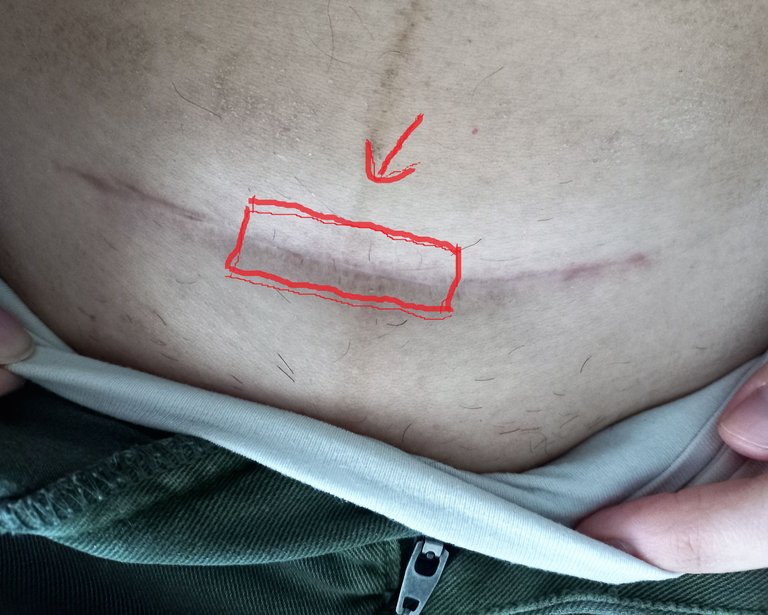
In this case, at first glance, I see a depressed area in the middle (pointed in red on the image). According to my experience, I see a beautiful healing process, with no hypertrophic signs, a fully closed wound and I see no major redness to an 8-week-old scar.
I then go on to palpation and mobility of the tissues around the scar. I gently touch the belly and the pubis to check for augmented or diminished sensitivity areas. Only then do I touch the scar and try to move it in all directions, one at a time. I observe how the scar moves when I gently pull the skin up, side to side and down.
In this case, when I tried to move the scar, that middle area on the red rectangle wasn't following along and the patient complained of slight discomfort and a pulling/tug sensation.
This can be an indicator of a small adherence of the skin to the fascia and might cause discomfort when the person tries to stand up, walk or do any movement that requires an extension of the trunks and hips.
So, my choice for this patient was to recommend an auto-massage protocol at home, if possible 10 min/day and 3 stretching exercises focusing all the anterior part of the body. I did an educational session with the patient to show and explain the movements to do on the scar and the creams that can be applied afterwards if none was deemed necessary by the doctor. We made another appointment for next week to follow the process and check on adherence in the middle area as well as the patient's discomfort with its mobilization.
In this case, thankfully, there were no serious seaquakes due to the scar and everything is going smoothly. On one hand, I know this might look like a beautiful scar to a doctor, and it is! I've seen scars with keloids before and in those cases the appearance is not the first complaint of the patient, but rather it's physical discomfort and pain.
However, I do believe it's important to also take care of a beautiful scar like this. From my point of view, there are also other important variables to take into consideration here.
I will always advocate for the referral of every patient with a scar to a physiotherapist and I hope to have shown you all why it is so important to take care of everyone!

Final considerations 🙌
Ufff, I've got a bit carried away there 😅. If you made it through here I thank you for your time! I hope that this helps health professionals out there on the blockchain and that we might bring better care to our patients.
As usual, 30% of the rewards of this post go to @med-hive so I can contribute to the growth of this wonderful community!
Last note, at the beginning of this post I intended to bring helpful general tips about this to the non-med hivers, including how to massage your scar. But, I thought it to be too long for one post and maybe too confusing since this is a more technical post.
However, I'll state here my promess of doing another post on how to massage your scar and with other helpful and validated general recommendations on scar management (note to self - it might take me a while, but I'll do it!) .
Take care and see you soon!

References:
- Khansa, Ibrahim MD; Harrison, Bridget MD; Janis, Jeffrey E. MD, FACS. Evidence-Based Scar Management: How to Improve Results with Technique and Technology. Plastic and Reconstructive Surgery 138(3S):p 165S-178S, September 2016. | DOI: 10.1097/PRS.0000000000002647
- Meaume S, Le Pillouer-Prost A, Richert B, Roseeuw D, Vadoud J. Management of scars: updated practical guidelines and use of silicones. Eur J Dermatol. 2014 Jul-Aug;24(4):435-43. doi: 10.1684/ejd.2014.2356. PMID: 25141160.

My previous health-related posts:
A guide for breathing | The importance of our diaphragm muscle
A 20-minute Pilates Class | Targeting Shoulder&Upper back | Mobility&Posture workout
MED-HIVE prompt week 2 | Non-Communicable Diseases | Physical Activity - Benefits & Recommendations
MED-HIVE July Prompt | The role of physical activity on sleep health
MED-HIVE September Prompt | My history with recurrent torticollis and neck pain
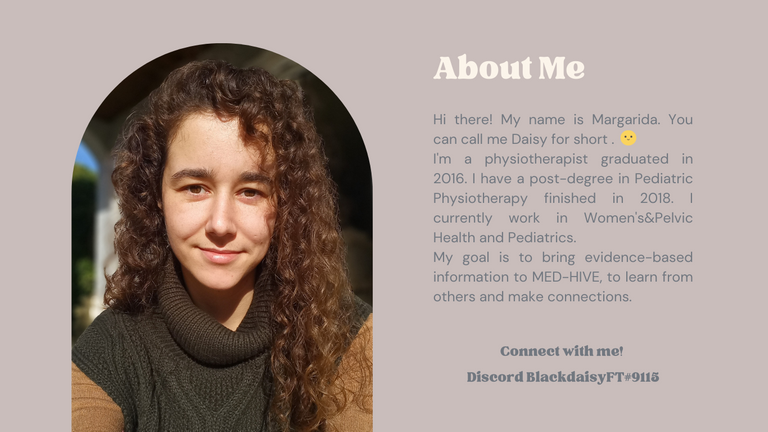
You are doing very good work. You have shared some information that is beneficial. I am quite sure somebody gets the benefit instantly from it and in my case, this knowledge may be helpful in the future in other ways.
Keep sharing knowledge like this and thank you.
Thank you so much @intishar 🤗🤗 I'm so glad this knowledge might be of help to you and other 🙌
Thank you for stopping by and taking the time to express your thoughts ☺️🙏
Thank you so much! 🙏🙏 I really appreciate it
This article is very helpful, thank you so much for sharing.
Thank you for taking the time to read it all 🤗🤗❤️ it's my pleasure to share a topic I'm so passionate about 🙌
I ve seen severely damaged scars from keloid before and really recovery had not been easy for most mums who had a caesarean done on them. Scars are real and medicine and you have don ea great work sharing about your experience with one. They ll be glad they had you.
Thanks so much for sharing this educative psot, I msure people may not know that some scars could be a problem if not well looked at.
Thank you for participating in this HEALTH WEEKLY DISCUSSION. The MED-HIVE community is grateful for your contribution on our primary goal of bringing health awareness to Hive.
We hope to grow more with your help and support!
Please consider supporting the med-hive community by subscribing and joining our Discord Channel. You can also go the extra mile and follow our voting trail, give this comment an upvote or even make HP delegations to the @med-hive account using the links bellow100HP|250HP|500HP|1000HP
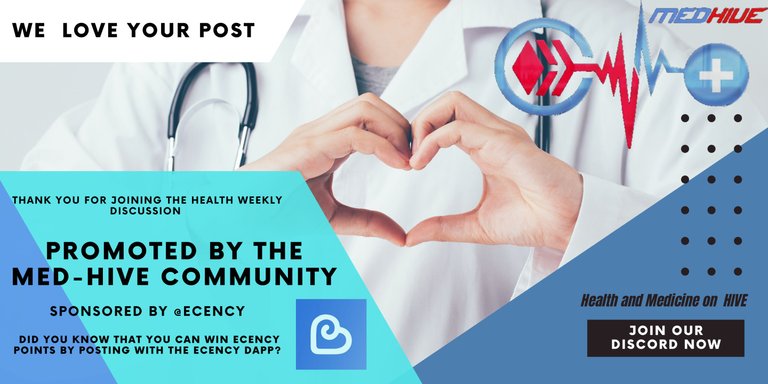
Use Ecency! Did you know you can earn Ecency Points just for your regular Hive activity such as posting, doing comments, and upvotes? Use those points to boost and promote your or others’ hivers posts. You can even tip your favourite authors directly! How cool is that?!
Congratulations @blackdaisyft! You received a personal badge!
Wait until the end of Power Up Day to find out the size of your Power-Bee.
May the Hive Power be with you!
You can view your badges on your board and compare yourself to others in the Ranking
Check out our last posts:
Congratulations @blackdaisyft! You received a personal badge!
Participate in the next Power Up Day and try to power-up more HIVE to get a bigger Power-Bee.
May the Hive Power be with you!
You can view your badges on your board and compare yourself to others in the Ranking
Check out our last posts: